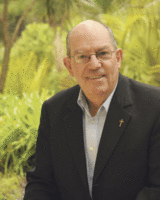Fr James Lyons
An excerpt from The joys and hopes of a priest on the road.
Fr James Lyons
The priesthood into which I was ordained viewed itself as quite separate from the laity. We were ‘set apart’ by a special and exclusive sacrament (Holy Orders), we dressed differently, lived our own rhythm, took our recreation separately (Monday was the ‘clergy holiday’) and were told to be ‘very careful’ about getting too friendly with lay people. This was, in part, for our own protection and the safe-guarding of celibacy, but it helped t
o foster a ‘clerical culture’ that reinforced the gap between clergy and laity.
The perceived status of the priest as ‘a man apart’, a status endorsed by the social and cultural mores of the day, set him up for a role that put him ‘out in front’, ideal for a ‘one man band’ approach to ministry. The shepherd set the pace and the sheep followed, obedient, passive, mostly silent but very supportive. Called, in their commitment, to lead, nourish and strengthen God’s people and to give their lives in service for God’s people, priests were cast in a role from which it was difficult to withdraw.
Sheep have played a major part in the economic life of New Zealand. There are fewer nowadays (40 million down from 70 million 25 years ago) but they are still everywhere and make the human population of less than five million look very small indeed. Differing from the biblical model, the New Zealand shepherd does not lead the sheep. The sheep do not follow the shepherd; they go ahead, moving forward, guided by the experience of the shepherd. There is relevance in this ‘revised’ model for the collaborative style of ministry that engages priests today. Rather than being ‘out in front’ of the people, the priest needs to be more an ‘enabler’, identifying and encouraging the gifts of the people to become the energy that drives and sustains the community. The priest cannot possibly ‘do everything’ and should never have been allowed to think he could, or was expected to. By standing behind his people, the priest is more easily seen as one of them; from this position he is also seen to trust the people, believing in their ability to make right decisions, to plan well and to take the community forward. There is a togetherness in this style of leadership that speaks of teamwork from which friendship and belonging are more likely to emerge.
I claim no special expertise, but finding myself as the only priest in parishes that have traditionally had as many as four, working with and among the people has been the only sensible option. And it has paid great dividends. It is as though the Holy Spirit has been guiding us to this point, deliberately and subtly shifting the goal posts, taking the initiative and forcing the exposure of the priesthood that lies within the baptismal gift of the people. Fewer priests does not have to signal ‘game over’ for the Church.
While it is a critical moment for the Church, I really believe it is opening the door to a new way of being Church, a way in which the gifts of all are recognised and called into service. The Church can truly be the People of God.
At the practical level, I have been freed of the burden of administration through the service of parishioners skilled in these matters. Ordination did not make me an accountant. Balance sheets and reconciling bank statements bring on nightmares; monthly accounts, wages, GST, ACC levies and the like are heavy weather. I have been blessed over many years with parish secretaries and financial advisers that have taken all that away from me. The parish is better served by a pastor unencumbered by the headaches of administration.
The love I feel for parish work is centred on people. Being invited into their lives is a huge privilege and the one that, more than anything else, has signposted my growth both as person and as priest.
Fr James Lyons is parish priest of the Cathedral of the Sacred Heart and a member of the Archdiocese of Wellington Pastoral Council.